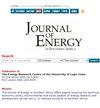莱索托2010年至2030年电力需求概况
IF 0.6
4区 工程技术
Q4 ENERGY & FUELS
引用次数: 3
摘要
本研究以2010年为基准年,对莱索托2010年至2030年的电力需求进行了分析。需求预测采用了国际原子能机构的能源需求分析模型,主要是因为它能够根据社会经济、技术和人口变量准确预测发展中经济体的需求。该模型与存在数据的实际数据相关性良好,并预测到2030年莱索托将实现54.2%的全国电气化率,其中城镇家庭电气化率为95%,农村家庭电气化率为14%,分别高于基准年的19.4%,54.1%和1.8%。此外,在同一时期,对最可能情景的预测给出了以下结果:最大需求将从121兆瓦增加到211兆瓦;家庭年平均能源消耗量会继续下降,由一九九八年千瓦时/户降至一千零九度;总用电量将从614 868兆瓦时增加到1 128 284兆瓦时。总体低增长率是由于家庭平均消费持续下降,这与国际惯例相反。预测结果的均方根百分比误差为1.5%,平均绝对百分比误差为1.3%,这意味着与实际数据的相关性较好,因此对结果的准确性有信心。本文章由计算机程序翻译,如有差异,请以英文原文为准。
Lesotho electricity demand profile from 2010 to 2030
This study undertook a 2010 to 2030 electricity demand profile for Lesotho, with 2010 used as the base year. The demand forecast was modelled using the International Atomic Energy Agency Model for Analysis of Energy Demand, largely because of its proven ability to accurately forecast demand in developing economies based on socio-economic, technology and demography variables. The model correlates well with the actual data, where data exists, and predicts that by 2030 Lesotho will achieve a national electrification rate of 54.2%, with 95% for urban households and 14% for rural households, up from 19.4%, 54.1% and 1.8% respectively in the base year. Moreover, in the same period, the forecast for the most likely scenario gives the following results: the maximum demand will increase to 211 MW from 121 MW; the annual average household energy consumption will continue its decline to 1 009 kWh/household from 1 998 kWh/household; and the total consumption will increase to 1 128 284 MWh from 614 868 MWh. The overall low growth rate is attributed to the consistently declining average household consumption that is contrary to international norms. The forecast results gave a root mean square percentage error of 1.5% and mean absolute percentage error of 1.3%, which implied good correlation with the actual data and, hence, confidence in the accuracy of the results.
求助全文
通过发布文献求助,成功后即可免费获取论文全文。
去求助
来源期刊

Journal of Energy in Southern Africa
ENERGY & FUELS-
CiteScore
3.00
自引率
0.00%
发文量
16
审稿时长
6 months
期刊介绍:
The journal has a regional focus on southern Africa. Manuscripts that are accepted for consideration to publish in the journal must address energy issues in southern Africa or have a clear component relevant to southern Africa, including research that was set-up or designed in the region. The southern African region is considered to be constituted by the following fifteen (15) countries: Angola, Botswana, Democratic Republic of Congo, Lesotho, Malawi, Madagascar, Mauritius, Mozambique, Namibia, Seychelles, South Africa, Swaziland, Tanzania, Zambia and Zimbabwe.
Within this broad field of energy research, topics of particular interest include energy efficiency, modelling, renewable energy, poverty, sustainable development, climate change mitigation, energy security, energy policy, energy governance, markets, technology and innovation.
 求助内容:
求助内容: 应助结果提醒方式:
应助结果提醒方式:


